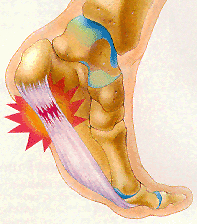Plantar Fasciitis Arch Pain – Heel Pain
The term Plantar Fasciitis is derived from the words plantar referring to the bottom of the foot and fascia which is a fibrous tissue that attaches to the bottom of the heel bone and extends forward to the toes. Plantar Fasciitis is simply referring to inflammation of the fascia. This is a very common condition that will affect approximately 1 out of every 8 people in their lifetime. The typical symptoms are a burning pain and irritation just forward of the calcaneus (heel bone). Sometimes this pain can lead to the arches of your feet. Pain is usually intensified after a period of rest, such as sleep or extended periods of sitting. Driving home from work, after sitting down for lunch or dinner are good examples of rest.
The first few steps in the morning are usually the toughest.

Heel pain in the morning
How did I get plantar fasciitis?
When you walk or run, your long arch acts as a spring rising and lowering with each step. What is actually happening is that upon weight bearing, your foot will elongate or lengthen, stretching the Fascia. When this “spring” action occurs, the fascia can stretch to the point that irritation or tearing of the fascia occur. This condition is often referred to as Plantar Fasciitis. Many people improperly use the term “heel spur” or “stone bruise”.
Why me?
Over the past 30 years I have been custom fabricating braces and foot orthotics for just about every type of foot, ankle and knee problem, about 70% of the custom orthotics that I have designed were for Plantar Fasciitis. I have heard many crazy theories on how people have acquired this condition. The fact is that anyone can develop this condition. Whether you are overweight, underweight, a triathlete or a couch potato. Plantar Fasciitis does not discriminate. If you need to know the most common causes, then read on, hopefully it will help you identify what you are doing right and wrong.
The # 1 cause of heel pain!
The most frequent cause of Plantar Fasciitis is an abnormal motion of the foot called excessive pronation. Normally, while walking or running, your foot will strike the ground on the outside edge of the heel, then begin to roll in and forward toward your toes Your arch should flatten slightly during this motion. If it flattens too much, you have what is commonly referred to as excessive pronation.
Other contributing factors for heel pain and plantar fasciitis
1) Sudden gain in weight and heel pain
Sometimes quick, excessive weight gain does not allow the body time to adjust to the extra load that it is now bearing. The connective tissues (tendons, ligaments and fascia) do not have adequate strength and flexibility to support the extra load. Now the connective tissues are over stretched and begin to fail.
2) Trauma and heel pain
It is a very common occurrence for someone to land improperly while jumping, running, climbing a ladder or even stepping off the curb. When your feet do not strike the ground properly you can over extend their mechanical limitations and damage the plantar fascia.
3) Flexible shoes and heel pain
A large majority of the people think that if you are having problems with your feet then you must wear soft shoes. Nothing could be further from the truth and I will explain why. If you are having a problem with your heels, ankle or knees it is safe to say that you are having a “biomechanical problem”. What this means is that your body mechanics are not functioning properly and feet are not aligned properly. For example, some people reason that if you wear soft, flexible shoes for walking then you are absorbing shock and reducing the shock forces on your feet. To a certain extent this is true but what most people do not realize is that a soft shoe will collapse under the impact forces. The soft sole of the shoe will compress to the point that the foot and ankle will rotate (tilt) in or out. This rotation will flatten the arch and strain all of the connective tissue. In this case, the plantar fascia will be over stretched causing irritation or tears in the fascia.
When you wear a firm, stable shoe the sole of the shoe will not collapse keeping your feet. This will keep your ankles aligned properly. The final result is reducing the stretching of the fascia. Yes, it is that simple. Just remember that a firm shoe will control your foot and ankle motion and in return reduce over stretching on the connective tissues.
4) Running or walking uphill.
Another common cause and irritation of Plantar Fasciitis is walking or running uphill. The position that the foot and ankle are forced into while walking uphill causes an excessive range of motion on the joints of the foot. This will cause the fascia and other connective tissues to be overstretched.
